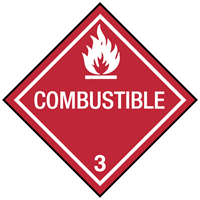
 Print
Print
Chemical Datasheet
2-AMINO-2-METHYL-1-PROPANOL |

|
Chemical Identifiers
| CAS Number |
UN/NA Number |
DOT Hazard Label |
USCG CHRIS Code |
- 124-68-5

|
|
|
|
| NIOSH Pocket Guide |
International Chem Safety Card |
|
none
|
|
NFPA 704
General Description
A clear light colored liquid. Insoluble in water and about the same density as water. Flash point 172°F. Used to make other chemicals.
Hazards
Reactivity Alerts
none
Air & Water Reactions
Insoluble in water.
Fire Hazard
Special Hazards of Combustion Products: Emits toxic fumes during fire conditions. (USCG, 1999)
Health Hazard
Causes severe irritation. Inhalation may be fatal as a result of spasm, inflammation, and edema of laryns and bronchi, chemical pneumonitis, and pulmonary edema. Symptoms of exposure may include burning sensation, coughing, wheezing, laryngitis, shortness of breath, headache, nausea and vomiting. (USCG, 1999)
Reactivity Profile
2-AMINO-2-METHYL-1-PROPANOL is an organic compound with both amine and alcohol substituents. Amines are chemical bases. They neutralize acids to form salts plus water. These acid-base reactions are exothermic. The amount of heat that is evolved per mole of amine in a neutralization is largely independent of the strength of the amine as a base. Amines may be incompatible with isocyanates, halogenated organics, peroxides, phenols (acidic), epoxides, anhydrides, and acid halides. Flammable gaseous hydrogen is generated by amines in combination with strong reducing agents, such as hydrides.
Belongs to the Following Reactive Group(s)
- Alcohols and Polyols
- Amines, Phosphines, and Pyridines
Potentially Incompatible Absorbents
Use caution: Liquids with this reactive group classification have been
known to react with the
absorbents
listed below.
- Cellulose-Based Absorbents
- Mineral-Based & Clay-Based Absorbents
Response Recommendations
Isolation and Evacuation
Excerpt from 128

[Flammable Liquids (Water-Immiscible)]:
IMMEDIATE PRECAUTIONARY MEASURE: Isolate spill or leak area for at least 50 meters (150 feet) in all directions.
LARGE SPILL: Consider initial downwind evacuation for at least 300 meters (1000 feet).
FIRE: If tank, rail car or tank truck is involved in a fire, ISOLATE for 800 meters (1/2 mile) in all directions; also, consider initial evacuation for 800 meters (1/2 mile) in all directions. (ERG, 2020)
Firefighting
Excerpt from 128

[Flammable Liquids (Water-Immiscible)]:
CAUTION: The majority of these products have a very low flash point. Use of water spray when fighting fire may be inefficient. CAUTION: For mixtures containing alcohol or polar solvent, alcohol-resistant foam may be more effective.
SMALL FIRE: Dry chemical, CO2, water spray or regular foam.
LARGE FIRE: Water spray, fog or regular foam. Avoid aiming straight or solid streams directly onto the product. If it can be done safely, move undamaged containers away from the area around the fire.
FIRE INVOLVING TANKS OR CAR/TRAILER LOADS: Fight fire from maximum distance or use unmanned master stream devices or monitor nozzles. Cool containers with flooding quantities of water until well after fire is out. For petroleum crude oil, do not spray water directly into a breached tank car. This can lead to a dangerous boil over. Withdraw immediately in case of rising sound from venting safety devices or discoloration of tank. ALWAYS stay away from tanks engulfed in fire. For massive fire, use unmanned master stream devices or monitor nozzles; if this is impossible, withdraw from area and let fire burn. (ERG, 2020)
Non-Fire Response
Excerpt from 128

[Flammable Liquids (Water-Immiscible)]:
ELIMINATE all ignition sources (no smoking, flares, sparks or flames) from immediate area. All equipment used when handling the product must be grounded. Do not touch or walk through spilled material. Stop leak if you can do it without risk. Prevent entry into waterways, sewers, basements or confined areas. A vapor-suppressing foam may be used to reduce vapors. Absorb or cover with dry earth, sand or other non-combustible material and transfer to containers. Use clean, non-sparking tools to collect absorbed material.
LARGE SPILL: Dike far ahead of liquid spill for later disposal. Water spray may reduce vapor, but may not prevent ignition in closed spaces. (ERG, 2020)
Protective Clothing
Self-contained breathing apparatus, rubber boots and heavy rubber gloves. (USCG, 1999)
DuPont Tychem® Suit Fabrics
No information available.
First Aid
INHALATION: Call for medical aid. Remove victim to fresh air. If breathing has stopped, give artificial respiration. If breathing is difficult, give oxygen.
EYES - OR - SKIN: Flush with copious amounts of water for at least 15 minutes while removing contaminated clothing and shoes. Assure adequate flushing of the eyes by separating the eyelids with the fingers. (USCG, 1999)
Physical Properties
Flash Point:
153°F
(USCG, 1999)
Lower Explosive Limit (LEL): data unavailable
Upper Explosive Limit (UEL): data unavailable
Autoignition Temperature: data unavailable
Melting Point:
89.6°F
(USCG, 1999)
Vapor Pressure: data unavailable
Vapor Density (Relative to Air): data unavailable
Specific Gravity:
0.935
(USCG, 1999)
- Less dense than water; will float
Boiling Point:
329°F
at 760 mmHg
(99+% compound)
(USCG, 1999)
Molecular Weight:
89.14
(USCG, 1999)
Water Solubility: data unavailable
Ionization Energy/Potential: data unavailable
IDLH: data unavailable
AEGLs (Acute Exposure Guideline Levels)
No AEGL information available.
ERPGs (Emergency Response Planning Guidelines)
No ERPG information available.
PACs (Protective Action Criteria)
| Chemical |
PAC-1 |
PAC-2 |
PAC-3 |
| Isobutanol-2-amine (124-68-5)
|
17 mg/m3 |
190 mg/m3 |
570 mg/m3 |
(DOE, 2018)
Regulatory Information
EPA Consolidated List of Lists
No regulatory information available.
CISA Chemical Facility Anti-Terrorism Standards (CFATS)
No regulatory information available.
OSHA Process Safety Management (PSM) Standard List
No regulatory information available.
Alternate Chemical Names
- 2-AMINO-1-HYDROXY-2-METHYLPROPANE
- 2-AMINO-2,2-DIMETHYLETHANOL
- 2-AMINO-2-METHYL-1-PROPANOL (90% OR LESS)
- 2-AMINO-2-METHYL-1-PROPANOL
- 2-AMINO-2-METHYLPROPANOL
- 2-AMINODIMETHYLETHANOL
- 2-AMINOISOBUTANOL
- AMP
- AMP (THINNER)
- AMP 95
- AMP REGULAR
- AMP-95
- BETA-AMINOISOBUTANOL
- 1,1-DIMETHYL-2-HYDROXYETHYLAMINE
- 2,2-DIMETHYLETHANOLAMINE
- 2-HYDROXY-1,1-DIMETHYLETHYLAMINE
- HYDROXY-TERT-BUTYLAMINE
- 2-HYDROXYMETHYL-2-PROPYLAMINE
- ISOBUTANOL AMINE
- ISOBUTANOL-2-AMINE
- 2-METHYL-2-AMINO-1-PROPANOL
- 2-METHYL-2-AMINOPROPANOL
- 1-PROPANOL, 2-AMINO-2-METHYL-


 Print
Print
